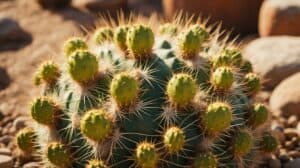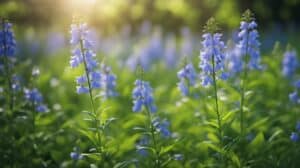Argyreia nervosa, commonly known as elephant creeper or Hawaiian baby woodrose, is a tropical vine native to Southeast Asia and the Indian subcontinent.
This plant is known for its psychoactive properties and has been used in traditional medicine and shamanic practices for centuries.
The plant contains several psychoactive compounds, including lysergamides, which are similar in structure to LSD.

Growing Argyreia nervosa can be a rewarding experience for those interested in exploring the psychedelic properties of this plant.
While it is not difficult to grow, there are some important considerations to keep in mind.
The plant requires a warm and humid environment, well-draining soil, and plenty of sunlight.
It is also important to note that the seeds of Argyreia nervosa are toxic and should not be ingested.
Instead, the active compounds can be extracted from the seeds using various methods.
In this article, we will explore the process of growing Argyreia nervosa and discuss some of the ways in which it can be used for its psychoactive properties.
Historical Significance

Traditional Uses
Argyreia nervosa, also known as Hawaiian baby woodrose, has been used for centuries in traditional medicine in India, where it is native.
The seeds of the plant contain various alkaloids, including lysergic acid amide (LSA), which has been used for its psychoactive properties.
In traditional medicine, the seeds have been used to treat various ailments, including gastrointestinal disorders, fever, and snake bites.
Cultural Importance
In addition to its traditional medicinal uses, Argyreia nervosa also holds cultural significance in India.
The plant is considered sacred in Hinduism and is often used in religious ceremonies.
It is also believed to have spiritual properties and is sometimes used in Ayurvedic medicine to promote spiritual well-being.
The plant’s psychoactive properties have also made it popular among Western counterculture movements.
In the 1960s and 1970s, Argyreia nervosa was used as a legal alternative to LSD, which was banned in many countries.
Today, the plant is still used by some individuals for its psychedelic effects.
Overall, Argyreia nervosa has a rich history of traditional use and cultural significance.
Its psychoactive properties have made it popular among certain groups, and its traditional medicinal uses continue to be studied for potential health benefits.
Cultivation Techniques

Optimal Soil Conditions
Argyreia Nervosa, commonly known as the Elephant Creeper, thrives in well-drained soil with a pH range of 6.0 to 7.5.
The soil should be rich in organic matter and have good aeration. The addition of compost or well-rotted manure can improve soil fertility and texture.
The plant prefers slightly acidic soil, so adding lime may be necessary in areas with alkaline soil.
Climate and Environment
The Elephant Creeper grows best in tropical and subtropical regions with warm temperatures and high humidity.
It can grow in full sun or partial shade, but it prefers some shade during the hottest part of the day.
The plant is sensitive to frost and cannot tolerate temperatures below 50°F (10°C).
In areas with cold winters, it can be grown as an annual or in a greenhouse.
Propagation Methods
Argyreia Nervosa can be propagated from seeds or cuttings.
Seeds should be planted in well-draining soil and kept moist until germination, which can take up to 2 weeks.
Cuttings can be taken from the stem or leaf, and should be planted in a well-draining potting mix.
The cuttings should be kept moist and in a warm, humid environment until they root, which usually takes 2-3 weeks.
It is important to note that the Elephant Creeper is a fast-growing vine that can reach up to 30 feet (9 meters) in length.
It requires support such as a trellis or fence to climb on. Regular pruning can help control its growth and shape.
With proper care and cultivation techniques, the Argyreia Nervosa can be a beautiful addition to any garden or landscape.
Psychoactive Properties

Active Compounds
Argyreia nervosa, commonly known as the Elephant Creeper, is a plant that has been used for its psychoactive properties for centuries.
The plant contains several active compounds, including ergine (also known as lysergic acid amide or LSA), which is a naturally occurring psychedelic alkaloid.
Ergine is chemically similar to LSD and produces similar effects, but it is less potent.
In addition to ergine, the plant also contains other psychoactive compounds such as isoergine, chanoclavine, and lysergol.
These compounds are believed to contribute to the plant’s psychoactive effects, but their specific effects on the human brain are not well understood.
Effects on the Human Brain
When consumed, the psychoactive compounds in Argyreia nervosa can produce a range of effects on the human brain.
These effects can vary depending on the dose, the individual’s tolerance, and the method of consumption.
Some of the common effects of consuming Argyreia nervosa include altered perception, changes in mood, and increased creativity.
Many users also report experiencing vivid visual hallucinations and an altered sense of time and space.
However, it is important to note that consuming Argyreia nervosa can also produce negative side effects such as nausea, vomiting, and anxiety.
In some cases, consuming high doses of the plant can lead to more serious side effects such as seizures and psychosis.
Overall, while Argyreia nervosa has been used for its psychoactive properties for centuries, its effects on the human brain are not well understood.
As with any psychoactive substance, it is important to use caution and moderation when consuming Argyreia nervosa to avoid negative side effects.
Legal and Ethical Considerations

Regulatory Status
Argyreia nervosa, commonly known as Elephant Creeper, is a legal plant in many parts of the world.
However, the plant and its seeds contain a compound called LSA (Lysergic Acid Amide), which is a naturally occurring psychedelic substance.
In some countries, LSA is classified as a controlled substance, and possession or consumption of the seeds may be illegal.
It is essential to check the local laws and regulations before growing or using Argyreia nervosa.
Safety and Responsible Use
While Argyreia nervosa has a long history of traditional use in Ayurvedic medicine, its psychedelic properties have gained attention in recent years.
It is crucial to approach the use of this plant with caution and responsibility.
The effects of LSA can vary depending on the dose, individual, and set and setting.
It is recommended to start with a low dose and have a trusted and sober sitter present during the experience.
Additionally, it is essential to respect the plant and its traditional use and not exploit it for commercial gain.
It is also important to consider the environmental impact of growing Argyreia nervosa and take steps to minimize harm to the ecosystem.
Overall, growing and using Argyreia nervosa can be a rewarding experience, but it is essential to be aware of the legal and ethical considerations and approach it with responsibility and respect.
Frequently Asked Questions

How can I successfully germinate Argyreia nervosa seeds?
Argyreia nervosa seeds are known to have a hard outer shell that makes them difficult to germinate.
To increase the chances of successful germination, it is recommended to soak the seeds in water for 24 hours before planting them in a well-draining soil mix.
The soil should be kept moist but not waterlogged, and the seeds should be provided with warmth and indirect sunlight.
It can take up to several weeks for the seeds to germinate.
What are the ideal growing conditions for the Elephant Creeper plant?
Argyreia nervosa, also known as the Elephant Creeper, thrives in warm, humid climates and prefers well-draining soil.
The plant requires full to partial sunlight and should be watered regularly to keep the soil moist but not waterlogged.
It can grow up to 30 feet in length, so it is important to provide it with ample space to climb and support.
Are there any special care instructions for Argyreia nervosa plants?
Argyreia nervosa plants require regular pruning to keep them from becoming too invasive and to promote healthy growth.
They are also susceptible to pests and diseases, so it is important to monitor the plant for any signs of damage or infestation.
Fertilizer can be applied during the growing season to promote healthy growth.
What are the recognized medicinal uses of Argyreia speciosa?
Argyreia speciosa, also known as Hawaiian Baby Woodrose, is known for its psychoactive properties and is often used in traditional medicine for its hallucinogenic effects.
It is important to note that the plant is not approved for medical use and can have negative side effects if consumed in large quantities.
How does Argyreia nervosa differ from Argyreia speciosa?
While both Argyreia nervosa and Argyreia speciosa are members of the same plant family, they differ in their chemical composition and psychoactive effects.
Argyreia nervosa is known for its mild psychoactive properties and is often used in traditional medicine for its calming effects, while Argyreia speciosa is known for its potent hallucinogenic effects.
Can you list some hallucinogenic plants found in Hawaii?
In addition to Argyreia speciosa, there are several other hallucinogenic plants found in Hawaii, including Psychotria viridis, Diplopterys cabrerana, and Mimosa hostilis.
It is important to note that the consumption of these plants can have negative side effects and should only be done under the guidance of a trained professional.














